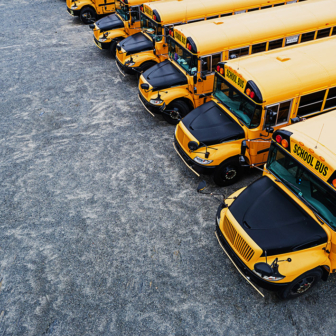THE collapse of the command economies of Australian schooling has been less dramatic and complete than that of the Soviet Union, but in other respects they have much in common.
Both imperiums enjoyed tremendous reach and power almost to the moment of their eclipse. As late as the 1960s the government school systems enrolled three in every four Australian students; most of the rest were in impoverished Catholic parish schools or, a tiny few, on private islands in a socialist sea. The grand departments dominated much of the curriculum, teacher education and employment, and policy. As in the case of the Soviet Union, few saw the end coming – everyone thought that the Catholic schools were the ones at risk of collapse, not the govvies – and no one really intended it.
And as in the USSR, the fatal blow was struck by friends, not enemies. The Karmel committee, riding to Whitlam’s instructions, devised a settlement of the “state aid” question resting on three different ways of funding three sectors, each to be governed by its own rules and conventions. The result was a bonanza and a liberation for the Catholic schools, and subsidies for the privates, that saw both come into competition with the government schools, and successfully so.
The departments, already rattled by the industrial and other consequences of the postwar enrolment boom, were panicked by declining prestige, authority and enrolment shares. They clutched at straws including “devolution,” “autonomy,” and “choice and diversity.” In a famous “Freedom and Authority Memorandum,” one director-general provided what turned out to be a national lead, telling his principals that from now on they were masters (or, very occasionally, mistresses) of their own fate. Zoning regulations were loosened; new “specialist” schools (in music and the performing arts, sport, technology and so on) were established; and selective schools and programs were expanded.
These developments were reviled by many, and particularly by employees and patrons of the government schools, partly out of self-interest, partly out of respect for the great principle that schools are a special kind of institution with the high purpose of seeing that the sins of the parents are not visited on the education or opportunities of the children. Schooling, in this view, is irreducibly a common, public undertaking, not a marketplace.
That view enjoyed no more success than the schools it defended. Governments of all political stripes pressed on; there was no going back on Karmel. The right of parents to choose a school on religious grounds became the right of increasingly prosperous parents to choose on any grounds at all. The consequences were rationalised by governments as a Good Thing. Savvy parents playing a competitive market would force schools to lift “performance.”
Into this desolate landscape has ridden the Grattan Institute, bent on finding out whether “competition” and its instrument “autonomy” are actually doing what governments hope and many others fear.
Grattan’s choice of topic and timing for its latest report is almost exquisite. Its motivating concern with what makes a good school system, rather than the currently conventional focus on what makes a good school, is salutary. Its findings are surprising, and will chasten both the federal government and the opposition as well as state governments. But The Myth of Markets in School Education is limited in diagnosis and limiting in prescription.
GRATTAN’s concern is to see whether schools do or could compete in ways that push up educational performance. “Evidence-based” as always, it takes a close look at what actually happens in a broadly representative group of schools, those of Southeast Queensland, home to around three million people. Grattan’s detailed examination of what actually does and doesn’t go on in these schools reveals that between 40 and 60 per cent of them don’t and can’t compete on “results,” and the rest do so only at the almost irrelevant margins.
It’s not that the schools lack the “autonomy” to compete. Contrary to popular and official assumption, Grattan finds that Australian schools enjoy a higher degree of autonomy than just about any in the OECD. What crimps the market as an instrument of “performance” is distance, transfer costs, school capacity limits, and relatively modest differences in schools’ educational performance. In the upshot, parents rarely take their sons and daughters from one school to another in pursuit of better results, and schools rarely lose or gain them. “Good schools don’t grow,” Grattan finds, “and bad ones don’t shrink.”
This is not good news for the federal government, and it is positively bad news for the Coalition. The government has put serious money into training principals to run more autonomous schools, and it has run hard on NAPLAN (the National Assessment Program – Literacy and Numeracy) and the MySchool website on the grounds that better-informed parents will choose better-performing schools and thus drive a better-performing system. But at least the government has Gonski as its big selling point.
The Coalition doesn’t and, worse, it has invested heavily in the autonomy and competition arguments. It has a long history of claiming that higher subsidies to non-government schools will provide more access and therefore more choice and more pressure on schools to perform.
Grattan’s finding on that score is, simply, no, they don’t, and they won’t. There isn’t much of a market now and “government can do little about it.” Grattan’s own study reinforces evidence from around the world in suggesting that any attempt to cut fees through subsidies or vouchers “will be expensive and will only slightly increase school competition.”
Grattan is to be thanked for putting the empirical blowtorch to both policy and conventional wisdom, but there is much more to be said on this difficult, even “wicked” problem.
Grattan acknowledges that by just about any available measure Australian schools are the most competitive in the OECD, but regards most of this competition as of no interest because it is not about “performance.” But surely it is more important to understand what competition does do than merely report on what it doesn’t? To find out where and when and for whom it works, and with what consequences?
MUCH of the competition between schools is focused on the moment when students move from primary school to secondary, and in some cases before children start school or when they’re moving into the last lap, at Year 10 or 11. If a family is going to shop it does so in anticipation, and that’s when schools – and secondary schools particularly – flutter their handkerchiefs.
Some schools approach this moment anxious about numbers, either getting them up or maintaining them, but most are looking for quality rather than (as Grattan implies) quantity. Schools compete for “the best” students, and the more students (families, that is) they can persuade to want them, the better placed they’ll be to select “the best.”
Educational performance plays a part of course, and there is much talk about “excellence” (code for “academic”) and, sotto voce, about Year 12 results, but neither side can really tell how good the schools are in this arena (that is, they are unable to detect “value add”), and both have other things to worry about as well.
Families, or more precisely those families with the necessary advantages in location, cultural capital and financial capacity, shop around for the best “fit” for their son or daughter, and for the best “reputation” they can reach and afford. So schools market on presentation (uniforms, buildings and grounds), a “caring” atmosphere, and clientele, which they regulate by means of entry requirements, scholarships and, of course, fees.
In this kind of competition, as opposed to the very specific form examined by Grattan, every school and every family is affected, for good or ill, even if they play no active part in the game. Once a family and a school find each other the family bestows its cultural and social capital on that school, usually because it already has more of both, and not on other schools, usually because they don’t. Every time one school forges a little bit further ahead, others fall a little bit further behind.
And this is where the consequences flow, for everyone. This form of competition is corrosive as well as pervasive. A report prepared for and accepted by the Gonski panel found that competition has served to increase both educational poverty and social segregation. It is probably not going too far to say that without any of the participants necessarily wanting it or even being aware of it, the educationally rich get richer at the expense of the educationally poor. At the extremes we now have educational slums and gated communities. Contrary to many arguments advanced in support of the government sector, this “residualisation” dynamic is hard at work within sectors as well as between them.
Seen in this light the obvious question is not whether competition is serving the stated policy ends but what is policy going to do to control it? But the obvious question might not be the right one.
IN A particularly useful account of the difference between “autonomy” and “empowerment” Grattan argues that schools can be empowered without being autonomous, and vice versa, and that it’s empowerment that matters. Empowerment is to be found in a relentless focus on student learning combined with the means of improving that learning, via teacher appraisal, mentoring and development particularly.
One half of Grattan’s distinction is probably beside the point. Since we’ve already got more autonomy and competition than just about any other system in the OECD, the question is not whether autonomy is necessary to empowerment, but how to empower autonomous (and competitive) schools.
I should first emphasise that there may well be no good answer to this question. The high degree of autonomy and competitiveness of Australian schools is one indicator of serious and perhaps insurmountable problems of steerage arising from industrial agreements that dictate resource use by systems and schools, from the sector system entrenched by Karmel, and from chronic conflict and confusion over state and federal government roles and responsibilities. We are not well placed to do anything with the degree of coherence and direction rightly urged by Grattan. But to the extent that we are, it may be found in just the place that Grattan suggests we stop looking.
Competition has not worked as governments intended but it certainly does work. It has been a powerful driver of change in the Australian school system, and unlike most such drivers it is self-fuelling and self-expanding. The greater the number of schools and families that get involved the more that have to, for reasons of ambition or of defence. We have probably passed the point of no return and, if so, it becomes important to decide whether the problem is in competition as such or in the particular way it has been conducted over the past several decades. Rather than trying to get the genie back in the bottle, perhaps it can be put to the right kind of work? An intriguing analogy suggests that it might.
The most successful sporting code in the country, the Australian Football League, has discovered that competition is an unbeatable driver of autonomous clubs and of the game as a whole, provided that all play by the same rules (particularly on player recruitment and transfer), and with more or less the same resources, so that every team and its fans can realistically believe that they’re in with a chance, if not this year, then soon. To risk an heroically mixed metaphor, by running a comp in which dog is not permitted to eat dog, the AFL has succeeded in lifting all boats, or just about all (and it accepts responsibility for those that aren’t).
The analogy is suggestive in several ways. At the most general level, it suggests that centralisation and decentralisation can – must? – go hand in hand, and so must competition and collaboration. Each side of these binaries depends on – expands? – the other.
More specifically, it suggests that governments have not had entirely the wrong idea, just 25 per cent or so of a good one. It suggests that a “good system” no longer consists of instructions enforced by hierarchies but of a few ground rules filled out by incentives and subsidies, conventions and understandings, evidence and argument. It suggests that the way to get schools to “implement” policies is to put them in circumstances in which they can and must learn from each other. It may even suggest how most or all schools might gradually come to join a common system, if by “system” we mean “framework.”
The analogy suggests that we may be further along the road to such a framework than might be supposed, and also that there is a long way to go. We have agreed goals for schooling (however conveniently abstract), a national curriculum, of sorts, an increasingly national Year 12 certification system, and some of the elements of a national scoreboard, although as yet narrow and narrowing. What’s left of Gonski is likely to establish the right national principle for funding even if it doesn’t get that principle anywhere near full practice.
On the other hand, we have wildly different capacities to participate in the comp. For schools, Gonski lite will reduce but not remove the mismatch between the size of the educational job and the size of the budget, and will leave quite untouched a regulatory regime that allows different schools to play by different rules, particularly in the crucial domain of student recruitment, exclusion and ejection. As for families, the mad legacy of Karmel lives on there too. Many families who can’t afford to pay fees do, and many of those who can don’t. We subsidise those who don’t need it and fail to give extra support to those who do.
No analogy is complete, of course. What makes a “club” or a “team” in schools? Not individual schools, unless of the behemoth variety exemplified by a few of the wealthy independents. Locality-based groups already half-exist, and have other things going for them as well, particularly if they were to include schools from two or all three of the present “sectors.” And what is the prize? There can be no one goal or grand final in schooling. “Performance” in the conventional educational sense is essential, of course, but so is the character and quality of relationships among students and between them and staff, and the mix of students and families. So the analogy won’t take us the whole way but it might take us further than looking to the past, or at what happens in Finland or Shanghai or Southeast Queensland. •




